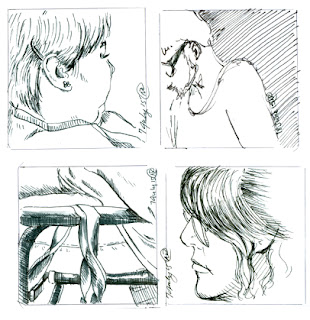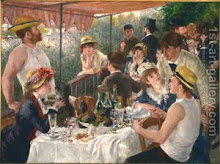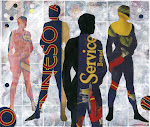1. Make It Yours
A
sketchbook doesn’t need to be expensive, and it doesn’t have to be purchased in
an art store. There are no rules about whether it needs to be hardbound,
wirebound or softcover, or about what kind of paper is inside. The important
thing is to use the sketchbook you like, and to make sure the paper will
support your favorite art materials, whether they’re pencils, pens, paints or
something else.
Find
your favorite sketchbook brand online, browse through what’s available at your
local stores, make your own book, use whatever you have lying around, or
discover one when you’re out and about. For that matter, if you prefer to use a
digital tablet, you can go that route, too! As long as you love it and want to
use it, it’s the sketchbook for you.
2. Keep It Portable
Decide
what size sketchbook is easiest to carry around with you. Many people prefer
pocket-sized sketchbooks, while others like them a little larger. Whatever your
preference, make sure it’s easy for you to transport so you’ll have the
opportunity to sketch anywhere you go. You can always find a spare minute
standing in line, in a waiting room, or on a break to sketch something,
provided you take your sketchbook with you when you leave the house. If you
like, you can keep larger sketchbooks in your home and simply leave your
on-the-go sketchbook in your bag or car to make sure you never forget it.
3. Relax and Accept Imperfection
Not
every page in your sketchbook will come out exactly the way you plan, and
that’s okay. Don’t be afraid to play around, capture ideas, or quickly draw
what you see. Allow yourself to simply enjoy the act of sketching and the
process of creating rather than worrying about the result. After all, if you
decide you don’t like where the page is going, you can always turn to the next
one. But don’t get into the habit of tearing out pages. Even the things you
don’t like today might later become fodder for a new idea.
4.
Draw Every Day
Use
your sketchbook every day, even if it’s only for a few minutes. Consistent
practice will improve your artistic abilities dramatically. Your accuracy,
speed and visual vocabulary will improve, and with it your confidence.
5. Experiment
Your
sketchbook is a place to experiment and play around. Try new and unexpected
materials and various styles. Make marks and messes. Add color, paper or other
ephemera to your pages. Use your sketchbook to discover what you like and what
you don’t. There are no rules except the ones you impose on yourself.
6. Divide the Page
If
having an entire blank page to work on feels too expansive, try breaking down
the page into smaller shapes you can draw within. Post-it Notes are handy to
use as templates. Just draw around them to get a smaller frame you can use to
focus your sketch. Try filling an entire sketchbook spread with frames and
capture quick moments or details of objects instead of trying to reproduce the
entire thing.
7. Jumpstart Your Pages
Sometimes
we just don’t know what we want to draw or how we should go about tackling that
dreaded white page. If this causes you to avoid your sketchbook, try marking up
the pages in advance to take the pressure off. Paint a few pages for a pop of
color, make random lines to surprise yourself with later, or let someone else
doodle or draw things for you to work around. If you have a young child, let
them at a page or two with a few crayons. Once the pages are no longer
pristine, you’ll worry less about making mistakes or playing around yourself.
8. Use It for Everything
Turn
your sketchbook into a constant companion and use it for everything. You can
doodle or sketch from observation. You can create patterns or practice hand
lettering. Sketch out concepts for larger art pieces you want to create, or
test art materials. Collect and attach things you like or don’t want to lose,
like tickets, business cards, leaves or flowers. Paste in pictures or decorate
your pages with washi tape. You can do anything–everything–you want to make
your sketchbook personal and useful to you.
And
don’t leave your life out of your sketchbook. Make grocery lists into art. Draw
out your favorite saying. Make an artful flowchart to plan your next vacation.
There is art in your everyday, so put it in your sketchbook.
9. Write in Your Sketchbook
Not
everything in your sketchbook has to be an image. You can make notes about
drawings, or just keep notes in general, including grocery lists, to-do lists
or calendars (wouldn’t they be fun to illustrate later?).
Use
it as a diary, make lists or collect quotes. Write down things that inspire
you, observations you make and snippets of dialogue you overhear. Create a list
of artists you love, techniques you want to try or things you want to practice.
Keep websites you like to visit or that have resources you find useful. Make
lists of artists you draw inspiration from, social media feeds and Pinterest board ideas. There are dozens
of ways to utilize writing in your sketchbook, so don’t be afraid to include
it.
10. Date Every Page
Be
sure you date each page in your sketchbook. This will help you see your
progression over time, and it will create a visual record of each year. Going
back to look at the places you went, the materials you tried, and the drawings
or paintings you liked (or didn’t) will be a rewarding experience and may even
spark new creative ideas. And while you’re at it, don’t forget to sign your pages,
too!
Ultimately,
how you use your sketchbook is up to you, but the most important thing to
remember is that your sketchbook should be personal and useful. It should be
exciting to take out and play in your sketchbook, so loosen up, do what you
enjoy and let yourself be inspired by the things you create.






No comments:
Post a Comment